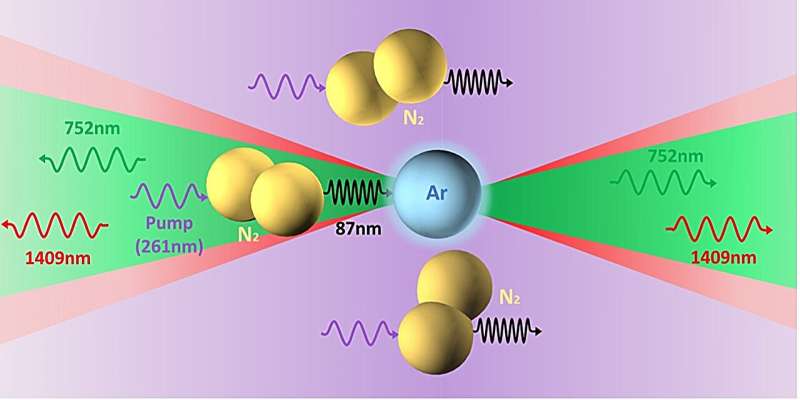"A Mechanism for Energy Transfer Between Nitrogen and Argon Enables Bidirectional Cascaded Lasing in Atmospheric Air"

August 23, 2024 feature
This article has been reviewed according to Science X's editorial process and policies. Editors have highlighted the following attributes while ensuring the content's credibility:
- fact-checked
- peer-reviewed publication
- trusted source
- proofread
by Ingrid Fadelli , Phys.org
To produce light, lasers typically rely on optical cavities, pairs of mirrors facing each other that amplify light by bouncing it back and forth. Recently, some physicists have been investigating the generation of 'laser light' in open air without the use of optical cavities, a phenomenon known as cavity-free lasing in atmospheric air.
Researchers at the University of California Los Angeles (UCLA) and Max Born Institute recently unveiled a physical mechanism that leads to this phenomenon. This mechanism, outlined in a paper in Physical Review Letters, consists of the photon-mediated transfer of energy from nitrogen (N2) to argon (Ar).
'We noticed that there appeared to be a previously unknown reduction in the ionization rate of Ar in the high field ionization regime (using a 261 nm pump laser) compared to that predicted by the PPT theory or time-dependent Schrödinger equation,' Chan Joshi, co-author of the paper, told Phys.org. 'We wanted to find out if 3-photon resonant absorption of 261 nm photons in Ar may be playing a role in the reduction.'
The recent study by Joshi's colleagues builds on the team's previous experimental efforts. When conducting their new experiments, the team observed that the 3-photon absorption of 261 nm photons by Ar atoms is followed by the emission of cascaded superfluorescence, specifically a cavity-free, bidirectional and laser-like emission.
'Furthermore, we unexpectedly discovered that the cascaded superfluorescence switched wavelengths if we used air that contains 1% Ar,' Zan Nie, the lead author of the paper said. 'Further investigation of this curious effect uncovered a new air lasing mechanism that facilitates radiative energy transfer from nitrogen to Ar.'
The new mechanism uncovered by Joshi and his colleagues was found to enable bidirectional, two colored, cascaded lasing in atmospheric air. This mechanism could thus open new avenues for the generation of backward air lasing, which has been a long-standing research goal within the physics community.
'Since ambient air has different components, we investigated this problem by first mixing argon with different components of ambient air, for example, the most and the second most abundant components: nitrogen and oxygen,' Joshi explained. 'It turned out that mixing nitrogen with argon showed the same results as using ambient air while mixing other gas like oxygen or helium didn't show the same results. Therefore, by this comparison experiment, we can deduct that the origin of the air lasing was due to the coupling between argon and nitrogen.'
Joshi and his colleagues also showed that N2 molecules in an electronically excited state exhibit nonlinear-3-photon absorption for 261 nm at slightly shifted frequencies than Ar. This shift serves as the upper excited state for the cascaded superfluorescence that the team observed. In their paper, the researchers introduce a theoretical model that explains the superfluorescence and its underlying mechanisms.
'The quest for efficient cavity-free lasing in open air has been ongoing for well over a decade,' said Misha Ivanov, co-author of the paper. 'The key—and rather challenging—goal is to achieve lasing in both directions. That is, you want to shoot a laser in the air and get the air to shoot a laser-like burst of light back at you. This would be very useful for remote sensing, but it is just mind-bogglingly cool.'
This recent study by Nie, Ivanov, Joshi and their colleagues unveiled a previously unknown photon-mediated mechanism that transfers energy from N2 to Ar, ultimately enabling bidirectional cascaded lasing in atmospheric air. In the future, this mechanism could be leveraged to realize backward air lasing, which could open new opportunities for the development of remote sensing technologies.
'Our plan for future research is to further investigate detailed physics of this mechanism, such as quantum beating,' added Nie. 'Simply stated, simultaneous excitation of multiple levels in Ar produces time dependent oscillations of charge density. These frequencies of these oscillations can reveal the existence of the previously unknown levels of not only Ar but also of vibrational-rotational levels of nitrogen that are important in the radiative coupling process.'
'We also have ideas for increasing the efficiency of the backward air lasing to promote this technique closer to real applications of remote sensing.'
More information: Nie, Z. et al. Bidirectional cascaded superfluorescent lasing in air enabled by resonant third harmonic photon exchange from nitrogen to argon, Physical Review Letters (2024). DOI: 10.1103/PhysRevLett.133.063201. On arXiv: arxiv.org/abs/2405.04089
Journal information: Physical Review Letters , arXiv
© 2024 Science X Network




